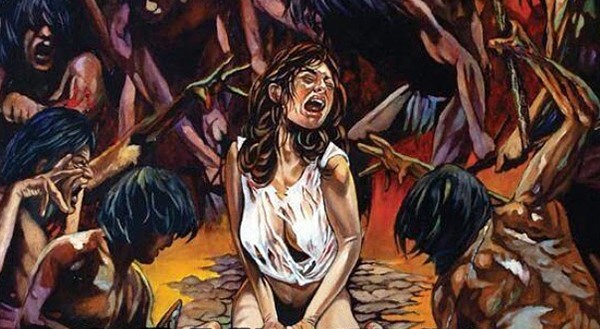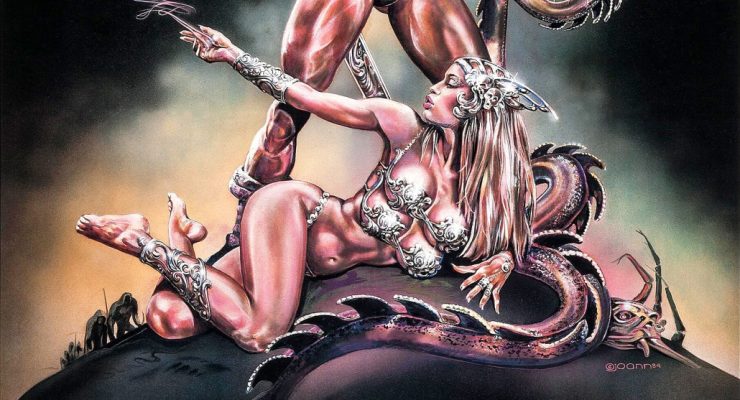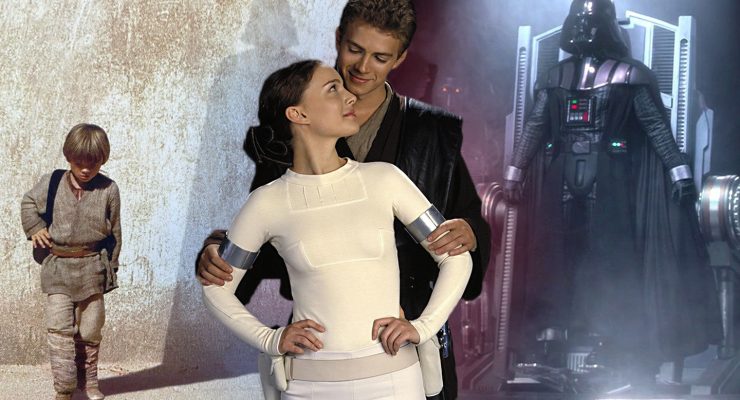During this time when very few new movies are getting released, we decided to revisit some stand out titles from the past year. One of these titles being Epic Pictures’ Artik, directed by Tom Botchii Skowronski. The horror film follows a comic book obsessed serial killer who teaches his son how to get away with a series of brutal murders until the boy befriends a mysterious man who threatens to expose everything. With the recent news that NoteforNote Music will be releasing Corey Wallace’s original score for the film, we decided to put a spotlight on Wallace’s work. In the below Q&A, Wallace talks about everything from his favorite scene in Artik, musically, to how he purposely detuned certain instruments before recording the score, in order to create a unique sound. Wallace’s Artik score will be available on all major digital sites beginning May 29, 2020.
First off, Congratulations on your upcoming score release for Artik. How did you get connected to or approached in composing for Artik? What was the initial appeal of the project?
Thank you very much. I contributed to my friend Kevin Lax’s score to Blumhouse’s The First Purge, doing some sample development, additional music, and orchestration, and it was Kevin who was approached by director Tom Botchii because he was looking for something with a similar energy. Kevin recommended me and sent me an early trailer, and I was immediately hooked by the visual style of the film. It looked so aggressive and edgy which is something I love to be a part of. After my first conversation with Tom, I was so excited because he wanted to approach the score using broken, ugly sounds, and I’d been waiting a long time to experiment with a score like that. All the horror scores I’ve done include that type of work to some degree, but never featured as prominently as in Artik.
At what point were you brought on to score the film? After the film was already complete or during production?
I came on during post when there was a fine cut. It wasn’t locked, there were some shots missing and no VFX, but the thrust of the piece was there. It’s unusual that I start scoring something earlier than that. Getting inspired by the visuals has always drawn me to film scoring from the very beginning, so I prefer to start when there’s a picture to look at. Funnily enough, I’m currently doing some pre-scoring on a film, that’s in pre-production, as we’re trying to nail down all the themes, motifs, and sound palette in advance so that when we do have picture we can get going immediately. The last time I did this was on my very first feature score for Behind Your Eyes. I wrote a 7-minute suite with mystery, action, and emotional themes based on the script, and a lot of it ended up sticking.
Is there a scene that you composed in Artik that you are most proud of that you can talk about and reveal why it stands out to you?
I really like the scene where Holton discovers Artik’s torture chair, heard in track 09 The Chair. It features a lot of what I like about this score. The start of the scene cuts viciously around images of the chair, from different angles and with lots of movement, and the score hits each cut aggressively which makes it feel more jagged and disorientating. We spent a lot of time crafting the sound and color of each hit, and we used violent cello bursts to catch the camera movements. From there, the score features handmade cello and synth drones layered with pulsing pizzicato cello and prepared piano hits. There are multiple layers of pulses that are all a bit different, so there’s this collage creating an arhythmic heartbeat that feels very anxious. Finally, when Holton finds a disturbing picture, the swell is composed of scratchy cello layers, that we sampled, and an electric guitar that is distorted with one of my favorite pieces of gear, the all-tube Thermionic Culture Vulture. The cue stands out to me because I like that we took a basic shape (hits, drone, pulse, build to an out) and made it unique and distinct to the film by the types of sounds used and the way they’re put together.
Did you create specific themes for some of the characters in Artik? If so, did you have a favorite character to score for?
We didn’t set out to make themes, in fact, quite the opposite. The idea was to create a sort of anti-score, using sounds and textures that aren’t typically used and use them in atypical ways. When a band or orchestra gets ready to play, the first thing they do is tune their instruments. When we were sampling guitar and cello sounds, the first thing we did was de-tune them. Without melodic themes, the palette of the score and the way it’s used becomes its identity. For example, Tom wanted to approach the score as if the movie was one long trailer, hitting tons of cuts and actions. That bombastic role of the score trying to smash through the screen becomes a thematic idea unto itself. This was a good place to start conceptually, but ultimately patterns emerge in the chaos and there are recurring sounds that are used thematically. The Artik Drone is probably used the most, which is a low, layered cello sound that has a nasty, menacing quality, used as it’s named for the titular character. Holton and Boy Adam have a very specific palette, though less distinct, which was the emotional backbone of the story. I’d say the most fun character to score was Flynn played by Lauren Ashley Carter. She has these really big, expressive eyes, and I love the way she acts with her entire face, the way her mouth moves for both big and small gestures. These gestures really gave me moments to latch onto, to bring in sounds or make musical turns based on how she was manipulating the scene. She gave her character a bit of a southern twang, so I gave her the banjo, both plucked and bowed.
How long did it take you to score Artik?
I spent about 6 weeks over 3 months working on the score. As long as there’s no hard distribution or festival deadline, I’ve found this type of schedule to be quite common and useful. The main advantage being that if I turn away from the score for a couple days or a week for a short-term gig, it allows me a fresh perspective when I return. There really is no substitute for time when it comes to the creative process. It’s difficult to be objective about what’s working or not in the heat of the moment, but after a break, I tend to experience the film more like a viewer. Once a complete pass of the score is done, I like to watch the entire film start to finish without stopping, something I haven’t done since seeing the film for the first time. This is really illuminating as far as the flow and pacing is concerned, maybe there’s too much music in one section or too little in another, or I can see if there are any missed opportunities to connect disparate moments through music.
You also scored NBC’s Siberia. What is your favorite memory from working on that show?
One of my best memories working on Siberia was getting to record live musicians nearly every week. I know not every show gets that privilege, so we were lucky. Looking back, I’m not quite sure how we did that considering we were writing 30+ minutes of music an episode, usually with only a week turnaround, and it was just me and my assistant Dash. What we recorded changed week to week, sometimes full orchestra or strings, especially for the season finale, piano, lots of percussion with Sidney Hopson and MB Gordy, and once we recorded a smaller ensemble of Violas, Cellos, and Bass, an ensemble that the late Jack Smalley taught me to use at USC. Violins are great, but you need a lot of them which gets expensive. Just using the lower strings can give you a dark and meaty sound with less players for less money.
How is your approach different to a show like Siberia, as opposed to a film like Artik?
Each project represents one of two halves to my scoring personality. Siberia represents the more traditional side, using melodic themes and orchestra, and Artik the more experimental side, featuring custom sampling of musical and non-musical sounds alike, and audio processing both analog and digital. Before coming to LA, my background was almost entirely in symphonic music, and my diet of film scores was mostly orchestral. That’s the music I loved and the music I wanted to write. As I adapted to modern aesthetics, as well as modern budgets, I’ve developed my own ways of producing music without using the orchestra, and sometimes without musicians at all. The last thing I ever wanted to do is fake the orchestra with a computer, and I learned the authentic value in making my own sounds and building a score around them (shout out to composer Freddie Wiedmann who taught me how to do this at USC). As an exercise, I once did an entire short film score using just one audio file, a droning, wavering violin sound, and manipulated it into everything I used in the score, even percussive sounds. It’s really exciting to unlock the potential in a sound source and discover something brand new that becomes unique to the film.
You have scored projects in many different genres, which have you found comes the most naturally for you?
I really love working in horror/thriller and animation. Making strong, bold choices with the music and the storytelling comes very natural to me, and usually in these genres the score gets to be very active and forward. I like to use lots of colors, whether through the orchestra or sound design, and there’s a huge range of palettes and musical vocabularies that lend themselves to these types of films. The project that probably blended these two worlds the best was my family-fantasy score to The Hybrids Family. It had all the earmarks of a genre film (mystery, suspense, action) but with a fun family twist.
What have you been watching at home during this time of quarantine?
Luckily, I’ve been working on a number of projects that were already in post, so I haven’t reached the “stuck-at-home-with-nothing-to-do” phase like some others. That said, there has been some extra down time on the weekends, and I’m doing a lot of comfort viewing rewatching older movies, especially from the 80s and 90s like Indiana Jones, Back to the Future, Total Recall, Goodfellas, As Good as it Gets, and American Pie. I finally watched Westworld season 1 and started watching Twin Peaks, and for new TV I watched Devs, The Outsider, Servant, and The Morning Show.
Who would be your dream director to collaborate with?
I’m sure you would rather I give you a name, but the dream director collaboration, to me, is a concept. It’s a real special thing when I click with a director, and that’s the dream, to be involved on a film where I’m constantly inspired and feel like I’m contributing something meaningful to the project. The great directors I’ve worked with have a way of motivating without controlling, being specific without micro-managing, and they can draw the best out of me. When the end result is something that I could not have come up with purely on my own, and the score and the film are better for it, that’s when I feel like the director-composer relationship is working at its finest. That said, in the modern horror landscape, I am absolutely blown away by what Ari Aster and Robert Eggers are doing. Not only are their films tremendous, but the way they use music is incredible.
Many thanks to Corey Wallace for taking the time for this interview.















